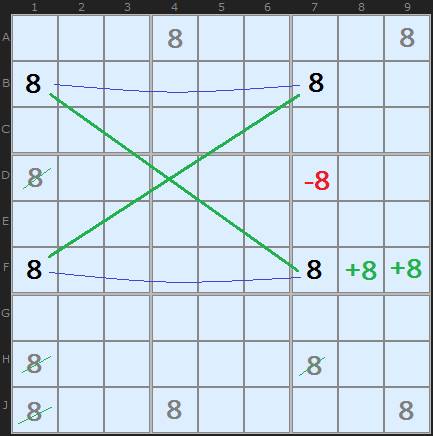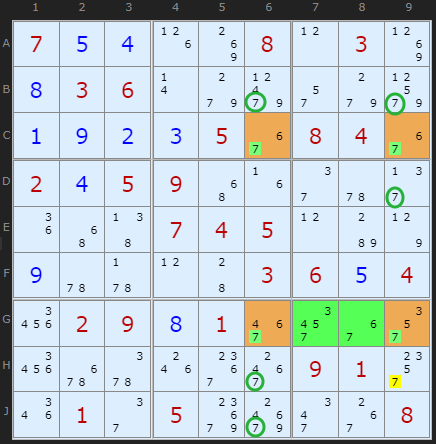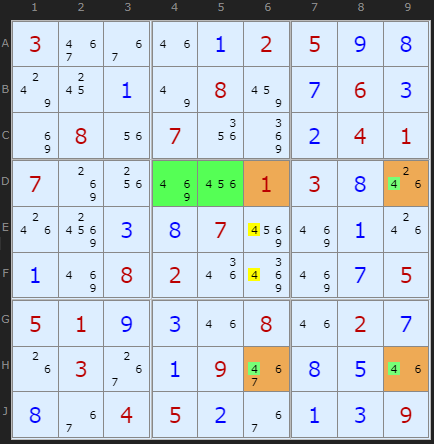| Main Page - Back |
|
From SudokuWiki.org, the puzzle solver's site |

Finned X-Wing
This is a very subtle yet beautiful extension of logic. We're looking at formations that could potentially be X-Wings but have a corner that's not quite right. In an X-Wing we are looking for four cells in a rectangle which contain a candidate N that exists just twice in either the two rows that form the rectangle or the two columns. Our Finned version is still a rectangle but it has extra candidates of the number in question that prevent one of the two pairs we need from existing.

These +8 cells are the 'fin'. The 'fin' or 'fillet' rule goes as follows:
If you can form an X-Wing by ignoring the fin cells, then you can keep your elimination of any cell that shares the same unit as all the cells in the fin.
It's important to remember we can only have one fin at a time!
In our example, the -8 is the only cell that shares a box with the +8 cells. It would have been eliminated anyway if the X-Wing were real. However, none of the other X-Wing eliminations are valid.
In our example, the -8 is the only cell that shares a box with the +8 cells. It would have been eliminated anyway if the X-Wing were real. However, none of the other X-Wing eliminations are valid.

Turning to a real example, consider the potential X-Wing on 7 marked in yellow in Figure 2. We would dearly like to remove all the 7s marked with a green circle. However, there are extra 7s in box 9, marked in green. These are the fin cells. But the fin rule allows us to remove the 7 on H9 at least (red circle).
Turn Grouped X-Cycles off
Sashimi Finned X-Wings
Grouped X-Cycles will be found in the solver before Sashimis so uncheck them to see the examples here.
It so happens, that when using the "fin" or 'filleting' rule, it is permissible for the X-Wing to be missing a corner in the finned box. The logic can still be applied! It's going to be fun to explain how and why it works, but first lets look at the example on the right.
We are looking at candidate 4. The fin is again marked in green but the corner of the X-Wing missing. There is no 4 at D6 - which so happens to be a clue, and therefore was never a candidate 4 there at any time! But it doesn't matter, we can remove the 4s from E6 and F6 because they are in the same box as the fin AND in the same column as the odd corner of the X-Wing, H6, in this example.
Where the Finned X-Wing is missing the candidate in the finned box, the type is called a Sashimi Finned X-Wing.
It is possible to consider this example in another way. Either there will be a 4 in D9 or there will be a 4 in one of the two cells {D4,D5}. If the later then the 4s in E6/F6 must go (same box situation) or the 4 in D9 forces a chain giving us 6 in H9 and 4 in H6 - which also eliminates the 4s in E6/F6.